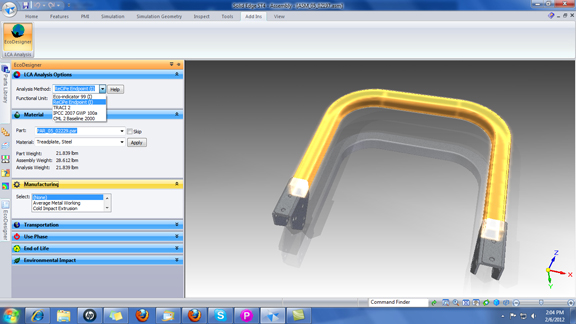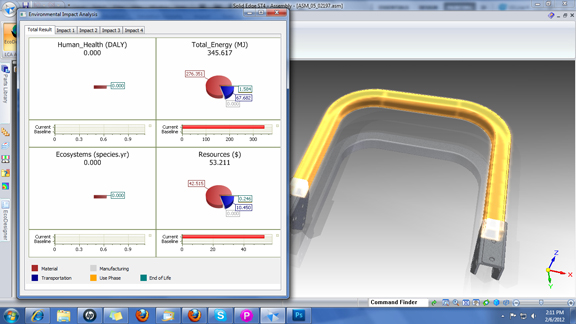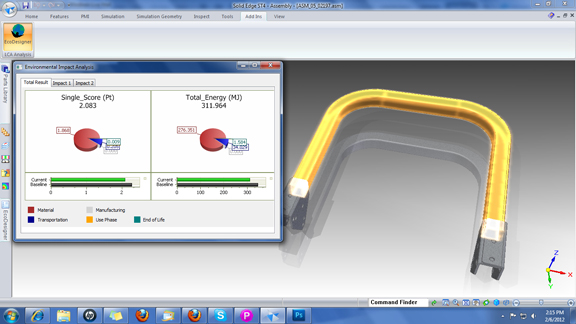February 7, 2012
Once, stress analysis was an optional module, available for purchase from the CAD vendors’ software partners. Today, most CAD packages offer some type of basic linear analysis feature, embedded right into the 3D modeling window. Today, the growing interest among engineers to pursue environment-friendly designs has spawned a slew of CAD-embedded life cycle assessment (LCA) modules. Early examples include SolidWorks Sustainability and Eco Materials Adviser for Autodesk Inventor. In the near future, we may see this feature as an integral part of design and engineering software.
The one for Solid Edge comes from Trayak, founded by a former Siemens PLM Software talent. Now serving as president and CEO of Trayak, Jagtap Prashant was once director of strategic marketing at Siemens PLM Software. He was also a program manager and consultant when his last employer was still known as UGS.
Once installed, Trayak’s EcoDesigner lives under the add-in tab inside Solid Edge (tested for this blog post with Solid Edge with Synchronous Technology). The one feature that distinguishes EcoDesigner from others is the choices of eco impact assessments it offers: EcoIndicator, ReCiPe, TRACI, CML, and so on. In addition to input fields for material and manufacturing methods, you may also enter transportation, either by part or for the entire assembly. If you know, for example, some parts that must be transported to the assembling site by truck, and others by train, you may specify them by distances of travel separately. On the other hand, if you don’t have such details, you may enter travel distance for the entire assembly.
Under Use Phase, EcoDesigner gives you the option to enter an estimated power use of your product for its lifespan, a handy input field for consumer electronics and electrical appliances. Under End of Life, you may enter the percentage of your product that can be recycled.
With these basic input, you can automatically calculate and obtain your design’s environmental impact as damage assessment, shown in Human Health (expressed in disability-adjusted life year) , Total Energy, Ecosystem Quality (expressed in Potentially Disappeared Fraction), and Resources (used). The software also gives you the option to consolidate all the output values into a single numeric score, giving you an easier method to compare different design variations.
Like SolidWorks Sustainability and Eco Materials Adviser, EcoDesigner gives you the option to use a design as baseline, then compare subsequent versions with the baseline to see the difference. Results can be exported as HTML reports.
Working inside a flexible modeling program like Solid Edge with Synchronous Technology, you can easily modify your design’s geometry (for example, by reducing materials by reducing wall thickness in shelled parts), then reassess your design’s eco impact. You cannot, however, modify your geometry while you’re in EcoDesigner. You’ll need to exit to return to the modeling environment.
For more, watch the video below:
Subscribe to our FREE magazine, FREE email newsletters or both!
About the Author
Kenneth Wong is Digital Engineering’s resident blogger and senior editor. Email him at [email protected] or share your thoughts on this article at digitaleng.news/facebook.
Follow DE








